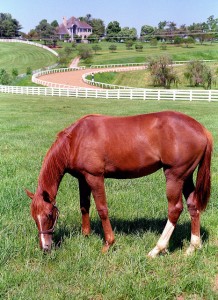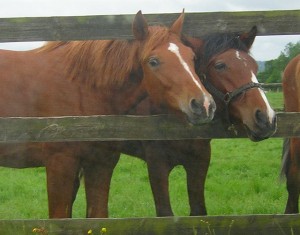The average racehorse’s career is pretty short: most animals usually retire at 6 or 7 years of age [1]. There are several possible options for the retired racehorse. Horses that performed well on the track may become breeding animals while others are sold and re-trained for other equestrian events, such as eventing or jumping. Some ex-racehorses may become companion animals. Racehorse retirement sanctuaries also exist, and they provide a permanent home for the horses, unlike racehorse rescues, which focus on rehabilitation and adoption [1].
The Thoroughbred Retirement Foundation (TRF) offers a program to incarcerated men and women, giving them the opportunity to learn how to care for animals and to gain vocational skills [2]. This provides retired racehorses with a home and also provides the inmates with emotional therapy.
An investigation was carried out by Weatherbys in 2008-2009 that followed racehorses that had left the British racetracks in 2006. Out of 7,590 horses, 2,404 were unaccounted for. Of the remaining horses that they were able to track down, 19% were retired to stud, 15.4% were exported for breeding or racing purposes, 11% were reported dead (reasons not given), and 2.5% were sold at auction. The remaining horses either went to Ireland or other parts of the UK to race or were retrained for other equestrian events [3].
However, the slaughter of retired racehorses does occur. Even horses that performed quite well can end up at slaughterhouses: Exceller, who defeated not one but two US Triple Crown winners (Seattle Slew and Affirmed) and won $1.6 million in purse money, was sent to Sweden to be slaughtered for human consumption. Ferdinand won the 1986 Kentucky Derby and the1987 Breeders’ Cup Classic, but he was still sent for slaughter in Japan in 2002 [4].
Sources:
- Animal Planet. 2012. Racehorse Welfare- After Racing. Available at: http://animal.discovery.com/tv/jockeys/horse-welfare/after-racing.html. Accessed April 1st, 2012.
- Thoroughbred Retirement Foundation. 2010. About TRF. Available at: http://www.trfinc.org/About-the-TRF-c1.html. Accessed April 1st, 2012.
- Weatherbys. 2009. A Career after Racing: an investigation into the whereabouts of racehorses which left training in 2006. Available at: http://www.britishhorseracing.com/resources/equine-science-and-welfare/retiredracehorse.pdf. Accessed April 1st, 2012.
- Maese, R. 2004. ‘Washed up’ Thoroughbreds often land at slaughterhouse: horse racing’s dirty little secret. The Orlando Sentinel, May 28th, 2004. Available at:http://www.rense.com/general53/unspeakable.htm. Accessed April 2nd, 2012.



